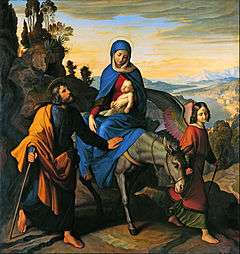Matthew 2:13
Matthew 2:13 is the thirteenth verse of the second chapter of the Gospel of Matthew in the New Testament. The magi have left after paying homage to the young Jesus. In this verse an angel warns Joseph that he must flee.
| Matthew 2:13 | |
|---|---|
← 2:12 2:14 → | |
 "The Flight into Egypt". Painting by Julius Schnorr von Carolsfeld (1828). | |
| Book | Gospel of Matthew |
| Christian Bible part | New Testament |
Content
In the King James Version of the Bible the text reads:
- And when they were departed, behold,
- the angel of the Lord appeareth to
- Joseph in a dream, saying, Arise, and
- take the young child and his mother,
- and flee into Egypt, and be thou there
- until I bring thee word: for Herod will
- seek the young child to destroy him.
The World English Bible translates the passage as:
- Now when they had departed, behold,
- an angel of the Lord appeared to
- Joseph in a dream, saying, "Arise
- and take the young child and his
- mother, and flee into Egypt, and stay
- there until I tell you, for Herod will
- seek the young child to destroy him."
For a collection of other versions see BibleHub Matthew 2:13.
Analysis
This verse opens a clear second section of Matthew 2 launching a series of dream inspired wanderings by the Holy Family. Its content is closely linked with the second half of Matthew 1. Joseph, after being ignored in the first half of the chapter, is again the central character. As in Matthew 1 Joseph is contacted by God in a dream. This verse is again clear that the child is not Joseph's.
Egypt was the logical place to seek refuge it was outside the dominions of King Herod and throughout the Old Testament it was the standard place of exile for those unsafe in Israel. At the time it had a large Jewish population, with about a third of Alexandria being Jewish.[1] Both regions were at the time part of the Roman Empire, making travel between them easy and relatively safe. The trip to Egypt occurs nowhere else in the New Testament gospels. The mention of Egypt is in keeping with Matthew's interest in Old Testament sources, with the links to Moses being the most prominent.[2]
References
- Craig S. Keener. A commentary on the Gospel of Matthew. Wm. B. Eerdmans Publishing, 1999. pg. 101
- France, R.T. The Gospel According to Matthew: an Introduction and Commentary. Leicester: Inter-Varsity, 1985. pg. 77
Further reading
- Albright, W.F. and C.S. Mann. "Matthew." The Anchor Bible Series. New York: Doubleday & Company, 1971.
- Brown, Raymond E. The Birth of the Messiah: A Commentary on the Infancy Narratives in Matthew and Luke. London: G. Chapman, 1977.
| Preceded by Matthew 2:12 |
Gospel of Matthew Chapter 2 |
Succeeded by Matthew 2:14 |